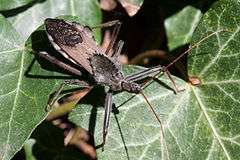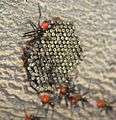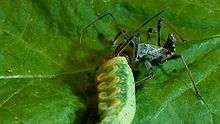Wheel bug
| Wheel bug | |
|---|---|
 | |
| Scientific classification | |
| Kingdom: | Animalia |
| Phylum: | Arthropoda |
| Class: | Insecta |
| Order: | Hemiptera |
| Family: | Reduviidae |
| Subfamily: | Harpactorinae |
| Genus: | Arilus |
| Species: | A. cristatus |
| Binomial name | |
| Arilus cristatus (Linnaeus, 1763) | |
The wheel bug (Arilus cristatus) is in the family Reduviidae (literally, "hangnail"),[1] which consists of assassin bugs.[2]The species is one of the largest terrestrial true bugs in North America, reaching up to 1.5 inches (38 mm) in length in their adult stage. A characteristic structure is the wheel-shaped pronotal armor. They are predators upon soft-bodied insects such as caterpillars, Japanese beetles, etc., which they pierce with their beak to inject salivary fluids that dissolve soft tissue.[3] Because most of their prey are pests, wheel bugs are considered as beneficial to the garden as ladybugs. They are also known for eating stinkbugs.
Wheel bugs are common in eastern North America, though they are found as far south as Mexico and Central America. [1] They are camouflaged and very shy, residing in leafy areas and hiding whenever possible.[4] They have membranous wings, allowing for clumsy, noisy flight which can easily be mistaken for the flight of a large grasshopper. The adult is gray to brownish gray in color and black shortly after molting, but the nymphs (which do not yet have the wheel-shaped structure) have bright red or orange abdomens. It was discovered in 1763 by Carl Linnaeus and taxonified in 1831 by Carl Wilhelm Hahn
Characteristics
The wheel bug has a characteristic dorsal crest, shaped like a wheel or cog. It moves and flies slowly, and in flight produces a noisy buzzing sound. As with other assassin bugs, its proboscis arises from the anterior end of its long, tubular head and unfolds forward when feeding. The bug plunges its beak into its victim, pinning its prey with its front legs. It then injects enzymes into the victim, paralyzing it and dissolving its insides, and proceeds to drain the resulting fluids.
The wheel bug is also noted to be very vicious in the wild, and cannibalistic behaviors between them have been noted; for example, nymphs may prey on one another and the female may feed on the male after mating is concluded.
It possesses two scent glands (red-orange in color) that can be everted from its abdomen, usually in reaction to being disturbed. The scent produced by it is not as powerful as that produced by the stink bug, but is still strong enough to be detected by humans.
Reproduction
The reproductive cycle of the wheel bug initiates in autumn. When a pair of wheel bugs encounter each other and have coitus, the female will lay 40-200 small, brown, cylindrical eggs on a tree twig, and eventually die. The eggs will hatch in the next spring into eighth millimeter long red nymphs, which will undergo 5 molts until they reach the adult stage the following summer.
Ecological significance
Wheel bugs are highly regarded by organic gardeners because they consume a variety of insects and their presence indicates a healthy, pesticide-free ecosystem. "They're the lion or the eagle of your food web," Dr. Michael J. Raupp, an entomologist at the University of Maryland, notes. "They sit on top. When you have these big, ferocious predators in your landscape, that tells me that this is a very healthy landscape, because all these other levels in your food web are intact." [5]
Gallery
 Wheel bug nymphs and eggs
Wheel bug nymphs and eggs Wheel bug nymphs and eggs on twig
Wheel bug nymphs and eggs on twig Nymph closeup
Nymph closeup Older nymph walking atop a fence
Older nymph walking atop a fence- Wheel bug adult
.png) Wheel bug on pool skimmer, NW Arkansas
Wheel bug on pool skimmer, NW Arkansas Wheel bug assassin bug vs. silver-spotted skipper caterpillar
Wheel bug assassin bug vs. silver-spotted skipper caterpillar Body approximately 3 inches (7.62 cm) in length, found in Fort Worth, TX, US.
Body approximately 3 inches (7.62 cm) in length, found in Fort Worth, TX, US. Body approximately 3 inches (7.62 cm) in length, found in Fort Worth, TX, US.
Body approximately 3 inches (7.62 cm) in length, found in Fort Worth, TX, US.
References
- 1 2 Johnson, Bill. "The Wheel Bug". Horticulture. 111.2.
- ↑ Columbia Electronic Encyclopedia. MAS Ultra. 2016 – via RaptorSearch.
- ↑ Creary, Scott. "Cristatus, Arilus". Organic Gardening. 61.5.
- ↑ Wheel Bug - Scientific Name, Classification, Taxonomy, North American Reach and Size
- ↑ Wanted Dead or Alive (No, Just Dead), Anne Raver, New York Times, November 27, 2013
- Bug Guide - Arilus cristatus - Wheel Bug
- Hilton Pond Center Article on the Wheel Bugs
- wheel bug on the UF / IFAS Featured Creatures web site
External links
| Wikimedia Commons has media related to Arilus cristatus. |
- "Arilus cristatus". Integrated Taxonomic Information System.
- Fagerlund, Richard (January 26, 2002). "Wheel bugs deliver world of hurt / Their bite causes excruciating pain". San Francisco Chronicle. Retrieved September 11, 2013.